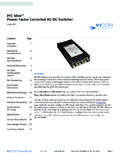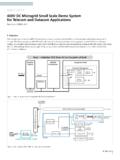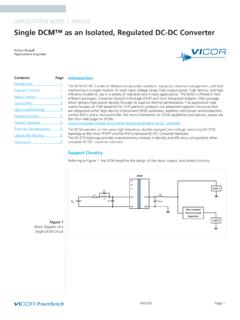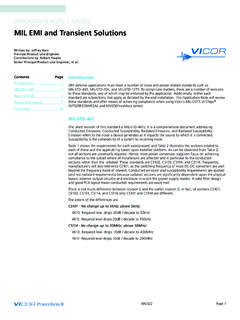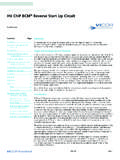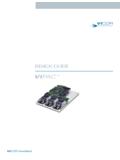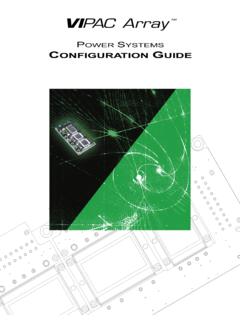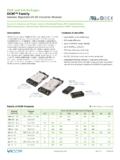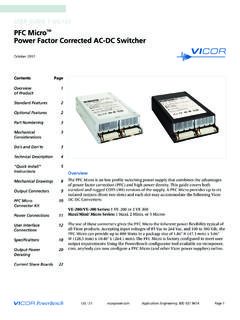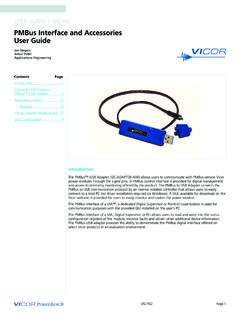Transcription of Prepared by Scott Speaks Vicor Reliability Engineering
1 " Reliability and MTBF Overview" Prepared by Scott SpeaksVicor Reliability Engineering2 of 10 IntroductionReliability is defined as the probability that a device will perform its required functionunder stated conditions for a specific period of time. Predicting with some degree ofconfidence is very dependant on correctly defining a number of parameters. For instance,choosing the distribution that matches the data is of primary importance. If a correctdistribution is not chosen, the results will not be reliable. The confidence, which dependson the sample size, must be adequate to make correct decisions. Individual componentfailure rates must be based on a large enough population and relevant to truly reflectpresent day normal usages. There are empirical considerations, such as determining theslope of the failure rate and calculating the activation energy, as well as environmentalfactors, such as temperature, humidity, and vibration.
2 Lastly, there are electrical stressorssuch as voltage and Engineering can be somewhat abstract in that it involves much statistics ; yet itis Engineering in its most practical form. Will the design perform its intended mission?Product Reliability is seen as a testament to the robustness of the design as well as theintegrity of the quality and manufacturing commitments of an organization. This paperexplains the basic concepts of Reliability as it applies to power supplies manufactured of 10 The Bathtub CurveThe life of a population of units can be divided into three distinct periods. Figure 1 showsthe Reliability bathtub curve which models the cradle to grave instantaneous failurerates vs. time. If we follow the slope from the start to where it begins to flatten out thiscan be considered the first period. The first period is characterized by a decreasing failurerate. It is what occurs during the early life of a population of units.
3 The weaker units dieoff leaving a population that is more rigorous. This first period is also called infantmortality period. The next period is the flat portion of the graph. It is called the normallife. Failures occur more in a random sequence during this time. It is difficult to predictwhich failure mode will manifest, but the rate of failures is predictable. Notice theconstant slope. The third period begins at the point where the slope begins to increase andextends to the end of the graph. This is what happens when units become old and begin tofail at an increasing 1. Reliability Bathtub CurveEarly Life PeriodVicor uses many methods to ensure the integrity of design. Some of the designtechniques include: burn-in (to stress devices under constant operating conditions); powercycling (to stress devices under the surges of turn-on and turn-off); temperature cycling(to mechanically and electrically stress devices over the temperature extremes); vibration;testing at the thermal destruct limits; highly accelerated stress and life testing; is well aware that in spite of using all these design tools, as well as manufacturingtools such as six sigma and quality improvement techniques, there will still be some early4 of 10failures due to the inability to control processes at the molecular level.
4 There is alwaysthe risk that, although the most up to date techniques are used in design and manufacture,early failures will occur. In order to offset these risks especially in newer product Vicor consumes some of the early useful life of a module via stress screening. Thistechnique allows the units to begin their operating life somewhere closer to the flatportion of the bathtub curve instead of at the initial peak, which represents the highestrisk of failure. Operating life is consumed via burn in and temperature cycling. Theamount of screening needed for acceptable quality is a function of the process grade aswell as history. M-Grade modules are screened more than I-Grade modules, and I-Grademodules are screened more than C-Grade Life PeriodAs the product matures, the weaker units die off, the failure rate becomes nearly constant,and modules have entered what is considered the normal life period.
5 This period ischaracterized by a relatively constant failure rate. The length of this period is referred toas the system life of a product or component. It is during this period of time that thelowest failure rate occurs. Notice how the amplitude on the bathtub curve is at its lowestduring this time. The useful life period is the most common time frame for makingreliability predictions. The failure rates calculated from MIL-HDBK-217 and Telcordia-332 apply to this period and to this period PeriodAs components begin to fatigue or wearout, failures occur at increasing rates. Wearout inpower supplies is usually caused by the breakdown of electrical components that aresubject to physical wear and electrical and thermal stress. It is this area of the graph thatthe MTBFs or FIT rates calculated in the useful life period no longer apply. A productwith a MTBF of 10 years can still exhibit wearout in two years.
6 No parts count methodcan predict the time to wearout of components. Electronics in general, and Vicor powersupplies in particular, are designed so that the useful life extends past the design life. Thisway wearout should never occur during the useful life of a module. For instance, mostelectronics are obsolete within 20 years; Vicor module MTBFs may extend 35 years AnalysisWeibull Analysis can be used as a method of determining where a population of modulesis on the bathtub curve. The Weibull distribution is a 3-parameter distribution. The threeparameters that make up the Weibull distribution are , , and time. The Weibulldistribution is given by:5 of 10 The Weibull parameter (beta) is the slope. It signifies the rate of failure. When < 1,the Weibull distribution models early failures of parts. When = 1, the Weibulldistribution models the exponential distribution. The exponential distribution is the modelfor the useful life period, signifying that random failures are occurring.
7 When = 3, theWeibull distribution models the normal distribution. This is the early wearout time. When = 10, rapid wearout is occurring. Vicor uses Weibull analysis extensively because thisdistribution allows modeling to be done with a minimal amount of failures. As said in his book The New Weibull Handbook, Use of the Weibull distributionprovides accurate failure analysis and risk predictions with extremely small samplesusing a simple and useful graphical plot. Solutions are possible at the earliest stage of aproblem without the requirement to crash a few more. 1 The results of various s on theWeibull analysis can be seen in the graph = = 1 Beta = 3 Beta = 10 CombinedNotice how, if all curves are combined, the resultant graph is similar to a bathtub Life Testing Accelerated life testing employs a variety of high stress test methods that shorten the lifeof a product or quicken the degradation of the product s performance.
8 The goal of suchtesting is to efficiently obtain performance data that, when properly analyzed, yieldsreasonable estimates of the product s life or performance under normal conditions. 2 Vicor uses a variety of high stress test methods that shorten the life of a product and/orquicken the degradation of product performance. This induces early failures that wouldsometimes manifest themselves in the early years of a product s life, and also allowsissued related to design tolerances to be discovered before volume manufacturing. Both 1 _ _e (T) =_6 of 10the type of stressor and the time under test are used to determine the normal are various stressors including, but not limited to, heat, humidity, temperature,vibration, and load. The effect of these stressors can be mathematically determined. Vicoruses accelerated testing on all new equation below is used to model acceleration due to temperature and is referred to asthe Arrhenius equation.
9 The Arrhenius equation relates how increased temperatureaccelerates the age of a product as compared to its normal operating = acceleration factorEa = activation energy in electron-volts (eV)k = Boltzmann s constant (k = x 10-5 eV/Tk)Tk = KelvinTu = reference junction temperature, in degrees Kelvin (K = C + 273)Tt = junction temperature during test, in degrees Kelvine = (base of the natural logarithms)Humidity is also a stressor. The equation below (Hallberg Peck) models the effect oftemperature and humidity combined on product = use environment relative humidityRHt = test environment relative humidityThe stressor that has the most profound effect on product life is thermal cycling. Theacceleration factor due to thermal cycling is given by the Coffin-Manson equation : Tl = lab temperature difference between highest and lowest operating temperature. Tf = field temperature difference between on and off stateFf = cycle frequency in the field (cycles/24hours).
10 Minimum number of = cycle frequency in the lab. Minimum number of six because most failures occur inthe first four TlAF=KEa TfFfFl 1/31eTmax f1 Tmax l7 of 10 Activation energy is derived from empirical data gathered during accelerated testing andis the slope of the failure rate at two different stressors. Activation energy represents theeffect that the applied stress will have on the product under test the stress factor beingheat, voltage, current, or vibration. Large activation energy indicates that the appliedstress will have a large effect on the life of the product. The activation energies that Vicoruses performing parts count calculations are based on MIL-HDBK-217F. Mean Time Between Failures (MTBF) Reliability is quantified as MTBF (Mean Time Between Failures) for repairable productand MTTF (Mean Time To Failure) for non-repairable product. A correct understandingof MTBF is important. A power supply with an MTBF of 40,000 hours does not meanthat the power supply should last for an average of 40,000 hours.
